Spotlight on David Kasnic
Oct 10, 2013
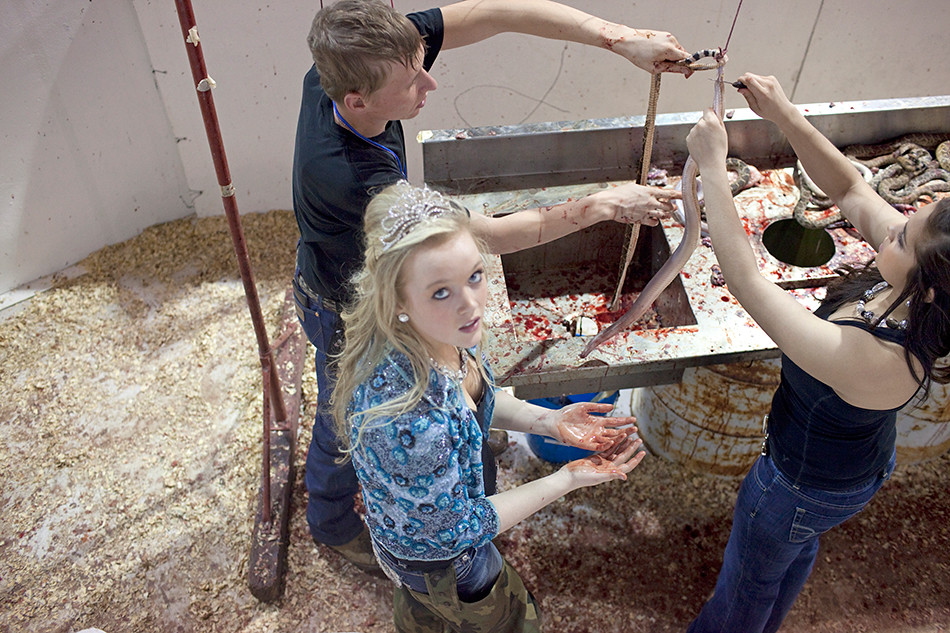
TID:
This is an intriguing image, can you tell us a little about the photo?
DAVID:
It's a picture of this girl named Kendra. And I got to know her pretty well. It was weird, I showed up to that event late. I was supposed to shoot the beauty pageant. It's called "Miss Snake Charmer" and they have it every year before the snake roundup. We ended up flying in on a Thursday and didn't know it was happening on that Thursday night. When we showed up on Friday we realized the pageant had already happened. So I was pretty bummed out.
When I made that picture, it was in the middle of a 4-day ordeal. I made that picture on a Saturday. They basically have these girls, Miss Snake Charmer and Miss Texas, who eventually ran for Miss USA, they have them running around doing these snake activities. It was really confusing. They were running around in snake pits. Basically, it's kind of like an "Ooooo/Ahhhh" attraction. Here's this pretty girl and she's handling these snakes and she's not afraid. And there's like a million snakes. They had her skin the snake, which is the picture that I took. I remember when she was doing it and I was shooting something else. I remember not be focused on it, but then I saw it and was like "holy shit, what the hell is this girl doing?" I don't think she realized I was taking her picture. I think she was more focused on the fact that she wasn't too stoked to be doing what she was doing.
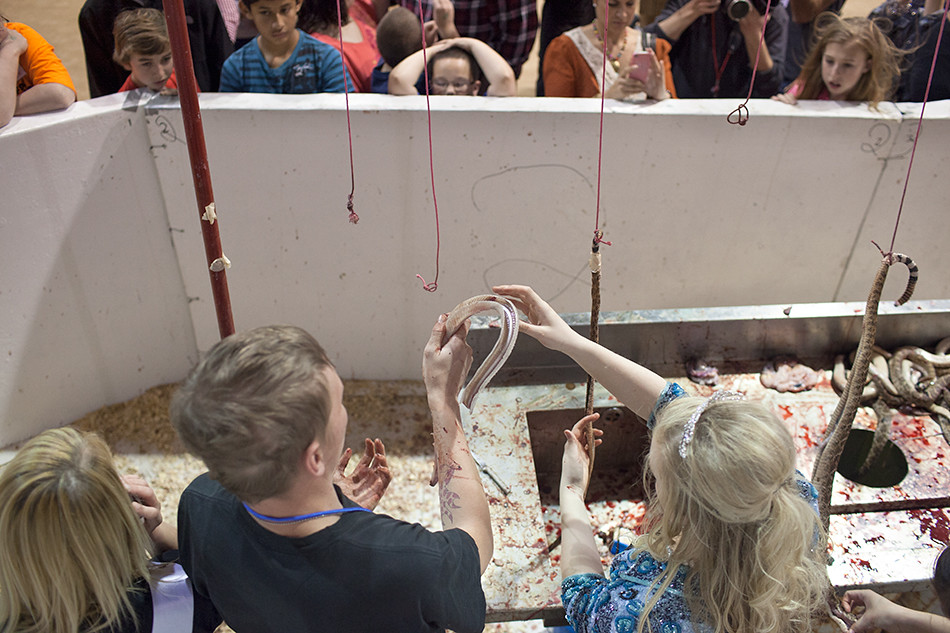
I was shooting above her. It looks like a rodeo. I was up in the bleachers and she was on the floor. I just was shooting because I thought "This is crazy." This young little done-up girl with makeup and hair, everything, and she's skinning snakes. Also, I'm not sure what type of practice this was, but they have these kids that skin snakes dip their hands in snake blood and then make handprints on a wall. That was right when I made the photo, she had just gotten the blood soaked on her hands, and to me, when I saw that, I thought "that's really interesting." It's not really so much as "gross" as like "that's a soulful picture." I'm not really interested in loud photography. I'm really drawn toward quiet moments. So when she looked up at me, I was thinking about in school how everyone said "don't get eye contact." I'm really drawn to eye contact. When she looked up at me and had a realization like "oh fuck, this guy with a non-cellphone camera is taking my picture?"
TID:
What were you shooting with? Was this shot on film?
DAVID:
Yes. I have a Mamiya 7 and I have a Canon 1v. I'm pretty sure this was shot digitally. I've been on a quest to try and make my digital pictures look like they were shot on film. At first I was using Alienskin for photoshop, but then I started using VSCO for Lightroom. If you tweak enough, you can start getting your stuff to look spot on like it was shot on film.
TID:
It definently has that "film-look" to it. You mentioned about her looking straight at you, but it looks like she's looking through you. She has this kind of 1000-yard stare going on.
DAVID:
I'm drawn to pictures that I have to look at for awhile. I'm instantly attracted to them and I don't know why. With that photo, everything that I was hoping for happened. It was really weird. Even photographing situations I didn't think were worth it, it ended up being worth it in the long run.
TID:
Why did you want to cover the Rattle Snake Roundup? And how did you get the access to it?

DAVID:
It's not necessarily that I wanted to cover it. It was during some downtime. I graduated (from Western Kentucky University) in December 2012. My family lives in Washington state. I spent some time with my family while occasionally taking a freelance assignment. My friend Matt hit me up and told me about this event.
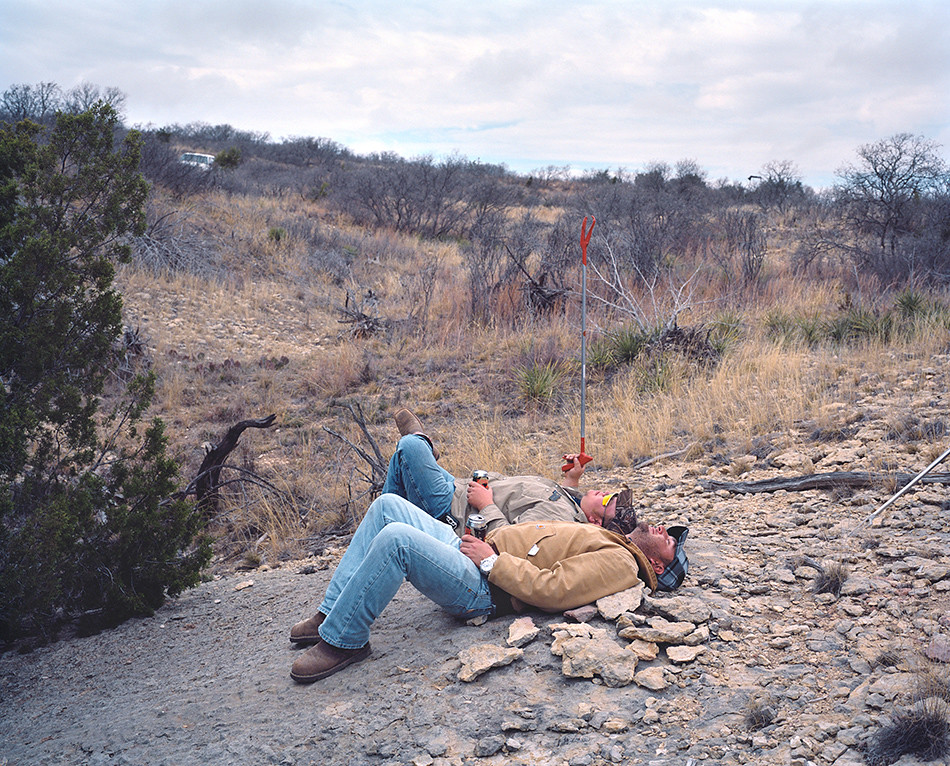
TID:
Is this Matt Eich?
DAVID:
Yeah. He was like "I'm going to this snake thing in a few weeks" and I was like "snake thing? That sounds tight." About six months before I graduated, I shifted off of what I always did in college, which was make photos of my friends. Shoot them having fun. The summer before I graduated, I was like "I'm bored."
I got really into going to community sporting events and seeing them in a weird way. When I was in school, I was like "that's lame. I'm not going. Football game? No." But then I started to realize that these things are really sweet. And if I go, I can just slow myself down. So I had my canon 1v, which is basically like a (5D) Mark II with film. And I would just slow down and shoot with that. I was really interested in shooting things I knew nothing about. I'm drawn to it. When Matt told me about the event, it sounded along the same americana lines. I'm really interested in americana. I think it's not my favorite photography work, but I like the idea of it.
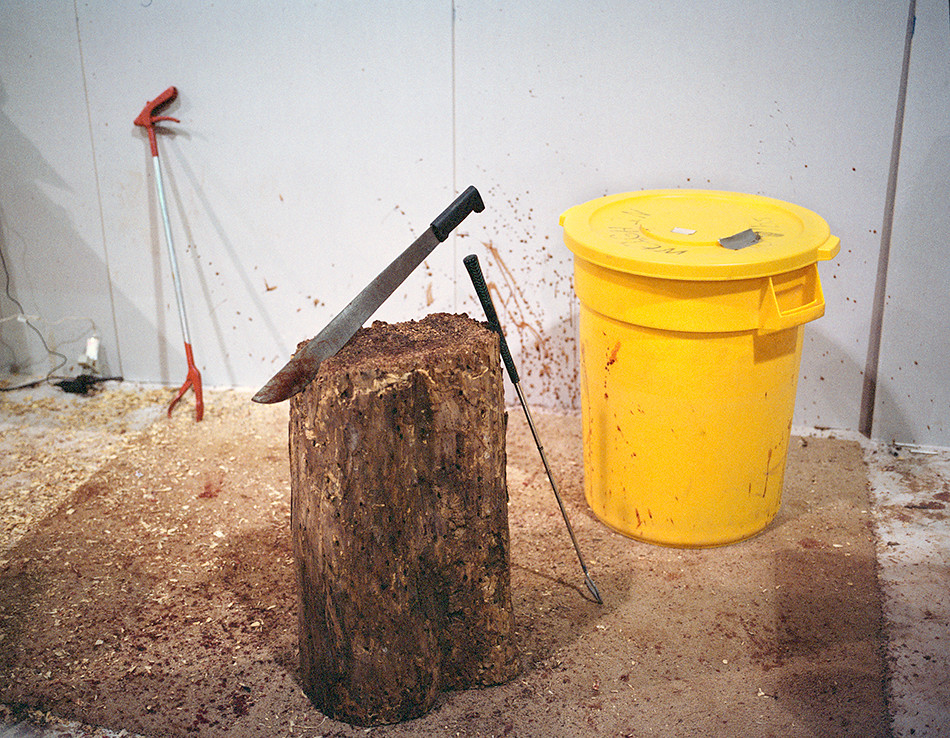
TID:
So you were shooting with Matt the whole time?
DAVID:
Yeah, and I also shot with my friend Ian (Bates) who was interning at the Dallas Morning News at the time. We all shared a room at the Days Inn. It had two electrical outlets for the whole room, so the three of us where fighting to charge batteries the whole time.
TID:
You talked about being drawn to quiet moments, how did that transfer over to shooting this event where people are catching poisonous snakes and then killing them?
DAVID:
Everything I was shooting with was manual focus, so that slows me down. When you're slowed down, your pictures aren't going to jump out at you. When going to this event, it's bad to have expectations. Go there with an opened mind. I try to follow that. But I had expectations. I wanted this to be a very soft-spoken piece of work. At some points I feel bad. Like, "I'm gonna shoot this and put it up on my website." But also, people didn't seem opposed to it. I tried to get people to fund me to go down there and shoot it, but no one backed me. But they did say "if you really want to do it, then go down there and shoot it." So I went down there and shot and scanned film for months and a few publications picked it up. I ended up making my money back.
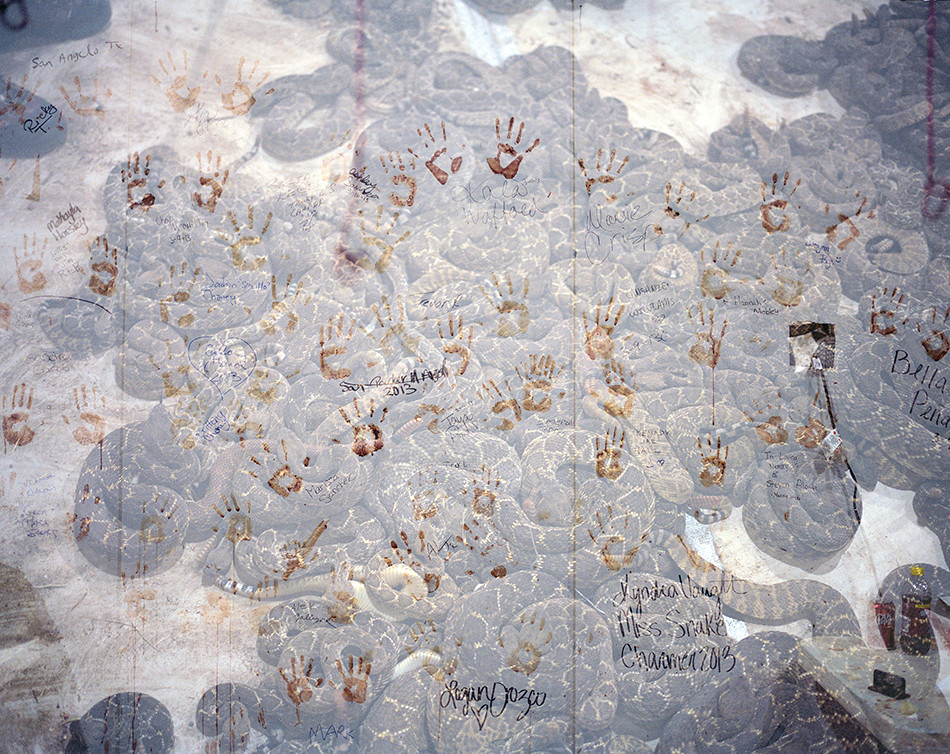
TID:
That's cool.
DAVID:
I have some scans I never did anything with because they were stereotypical photos. It's like "an angry snake." I'm not trying to show that. I want my pictures to make people think.
TID:
Let's talk about the actual moment and the moments leading up to the photograph of the girl. How did you approach it?
DAVID:
I was talking with an organizer of the event and saw that situation happening below me (the round-up was held inside of a coliseum, so I was in the stands above and she was right below me) so I walked over. I had walked by that area a day or two previously. Seen the snake blood, seen the handprints of blood on the wall but this situation happening was different because of who was in it. Kyndra seemed odd and out of place considering the left over bloody snakes on the table. And although the pictures before, her back is turned away from me, and after, she is smiling at me, that one moment where she first turned and noticed I was taking pictures of her.
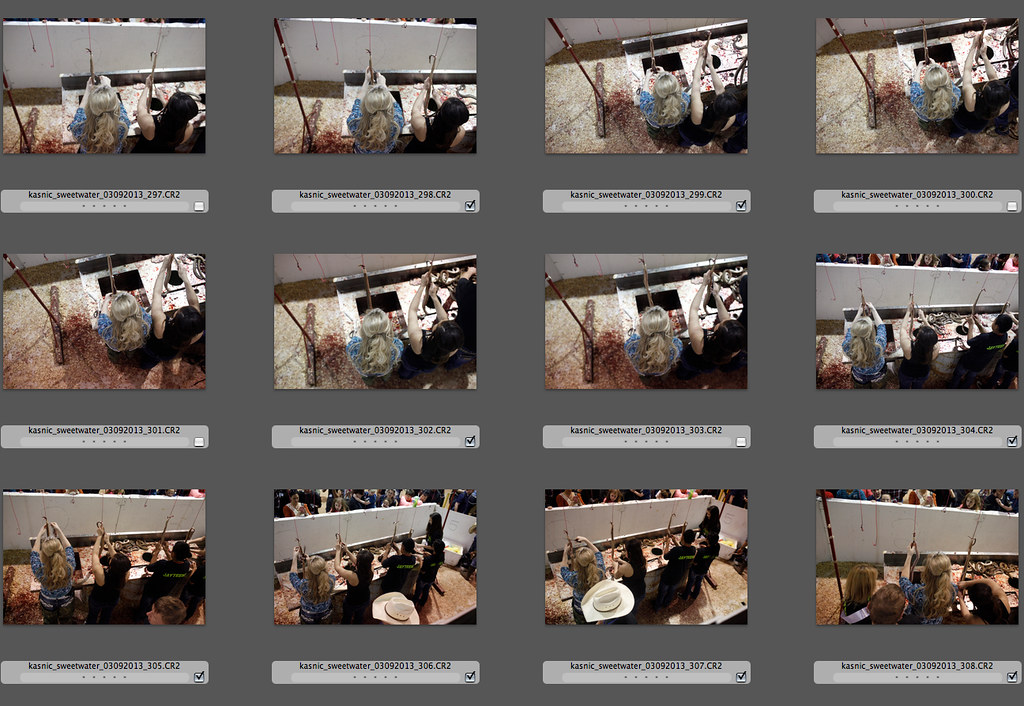
TID:
So it's a thought provoking event in the sense that people are killing animals. You touched on that fact that the people participating in the event didn't care that you were there, but were there any challenges that you had to deal with? In terms of access?
DAVID:
Me, Matt and Ian went on this all-day rattlesnake hunt. We hit up Wal-Mart and had to wait for these dudes to go out to this place, somewhere in the middle of the desert, and they kept saying "We hunt the snakes with gas. It's not illegal." They kept emphasizing that. I'm not totally cool with that, but I understood it.
CNN ran the pictures. There was 70-80 comments of people bashing the event, people who participated in the round up who weren't happy and both sides actually attached me personally. They called it shoddy journalism. It's not necessarily journalism. It's more so " I think this is interesting and I want more people to see it." There's no gimmicks here. I'm not putting anything in or taking anything out of these pictures. They're just pictures of what's going on.
TID:
How did you overcome these challenges?
DAVID:
I had a great time there. I guess the main challenge was trying to fit in. We went to a party friday night hosted by the Jaycees, the group that organizes the snake roundup. They weren't cool with us. We seemed pretty isolated. Matt and Ian were trying to shoot the party. Some were really nice. Matt was shooting for The New Yorker. A lot of the people thought we were trying to exploit them. That's not what I was trying to do.

TID:
Do you usually photograph with other photographers?
DAVID:
Sometimes. I like hanging with friends, driving around aimlessly and taking pictures all day.
TID:
What did you learn from photographing this event?
DAVID:
Snakes are cool. Also, Texas is a really great state to make pictures in.
TID:
What advice do you have for photographers?

DAVID:
Man, I need all the advice I can get (laughs). I'm just a freshman, still. I wanna keep that attitude for the rest of my life. A lot of people up here in New York are really arrogant about it. Like, yeah, you're taking pictures, but don't treat it like you're curing cancer. I think some people, it goes to their heads really fast. It's amazing how many photographers there are, but none of them want to shoot in New York. They're all trying to shoot in different countries. I grew up in the country and went to college in the country. I've only lived in a city once, and Seattle isn't comparable to New York. Working at the Journal this summer kicked my ass, but I think it's so fascinating at the same time. I get to see graffiti and people on top of building and giant flocks of birds. Those moments make me realize that I'm stoked to live in Brooklyn, at least for a limited time. It's just a really interesting city.
:::BIO:::
Raised in Wenatchee, Washington, a small town known for it's large apple production, David Kasnic is a photographer based in Brooklyn, New York. After graduating from Western Kentucky University in 2012, he moved to New York City in May 2013 to intern with The Wall Street Journal photography department for three months. He is currently available for freelance work anywhere you'd like to send him.
c. 1.509.264.7726
You can see more of his work here:
EDITOR'S NOTE:
Special thanks for week's interview, who was done by regular contributor Andrew Lamberson. Lamberson is is a freelance photographer and photo editor in Brooklyn, New York. You can see his work here: